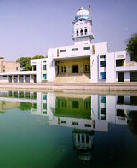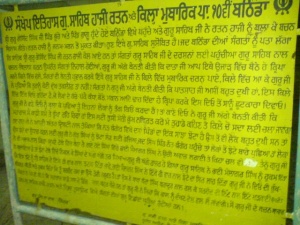Gurdwara Haji Rattan
While on his way to Talwandi Sabo Guru Gobind Singh camped here for the night outside the mausoleum of the Muslim saint Haji Rattan. The tomb keepers tried to dissuade the Guru from sleeping here with the excuse that the place was haunted. Since the Guru neither believed in tombs or ghosts he spent the night here to show the people that such superstitions were not followed by Sikhs.
On of the most intriguing figures in the book is that of the Haji Baba Ratan of Bhatinda in Punjab. Hindus, Muslims and Sikhs all claim him to be their own despite his strong Muslim connections. According to one legend he was a companion of the Prophet Muhammad (PBUH) and lived for over 700 years. The first references to Haji Ratan in Islamic literature date back to twelfth century. Several Hadith collectors traveled from as far as Andalusia and Central Asia to collect the supposed traditions from him. Abu Marwan Andalusi, a Spanish Muslim chronicler, visited Haji Ratan and penned an interesting sketch of him. ‘When he arrived at the Baba’s monastery, he was taken aback to see an ancient, wrinkled man, his cheeks covered with hair ‘as white as cotton’. The Baba addressed him in a language he could not understand, claiming, as was later translated for him, that he was present in Medina during the famed Battle of the Trench…At that time, he said, he was just fourteen years old. When the Prophet saw him laboring at the trenches, he blessed him with a long life.’
While on his way to Talwandi Sabo Guru Gobind Singh camped here for the night outside the mausoleum of the Muslim saint Haji Rattan. The tomb keepers tried to dissuade the Guru from sleeping here with the excuse that the place was haunted. Since the Guru neither believed in tombs or ghosts he spent the night here to show the people that such superstitions were not followed by Sikhs.


